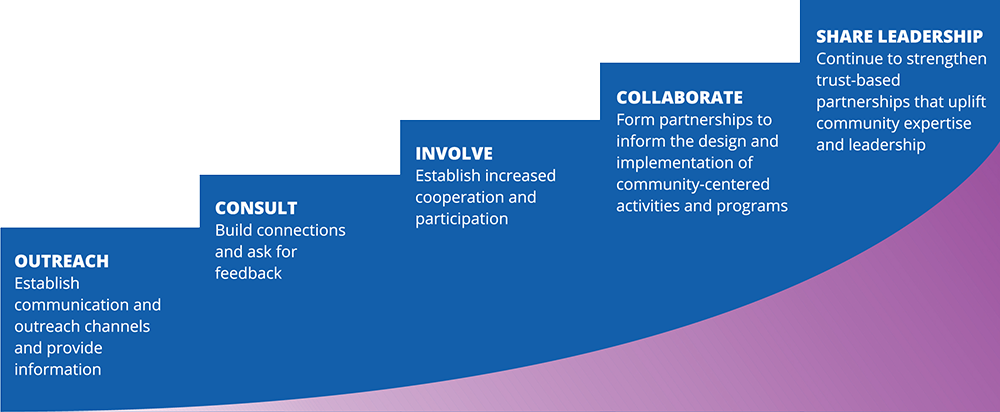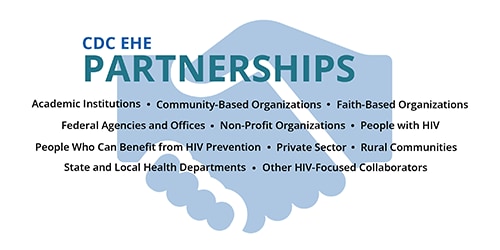Visit the COVID-19 and HIV page for the latest updates on the novel coronavirus outbreak and HIV.

Community Involvement
Passionate activism from advocates and community partners has driven decades of progress in reducing new HIV infections in the United States. As a whole-of-society initiative, Ending the HIV Epidemic in the U.S. (EHE) is by its nature a community-focused health equity intervention. For EHE to be successful, HIV interventions must reach the people and communities who could benefit.
Community engagement has been a key part of HIV prevention work since the beginning of the epidemic, and ongoing community engagement is core to EHE’s success. As such, EHE focuses on innovative, community-driven solutions to leverage scientific advances in HIV prevention, diagnosis, treatment, and outbreak response.
Through EHE, CDC does not just direct resources to communities – it gives local leaders the flexibility to design and implement prevention strategies tailored to the specific needs of their communities. As part of this approach, all EHE jurisdictions must allocate at least 25% of their EHE funding to support programs and community engagement activities led by community-based organizations.
Effective Engagement
Through EHE and other HIV prevention efforts, CDC involves communities affected by HIV in the development and implementation of innovative, culturally responsive, and equity-focused HIV prevention strategies, programs, research, and other initiatives. These engagement activities are designed to foster shared, collaborative leadership in efforts to achieve EHE goals between CDC and communities affected by HIV.
CDC’s process for increasing community involvement, trust, communication, and impact

Examples of this process in action are:
- Consistently engaging with the community to better understand community needs and inform CDC’s EHE and other activities, including by facilitating regular regional community engagement Town Hall and listening sessions; supporting and participating in conferences and other events; and sharing information about CDC’s EHE activities and ongoing partner and community engagement efforts
- Building and strengthening collaborations with diverse partners to identify and implement equity-focused strategies, including national, regional, and local HIV advocacy organizations; advocates; people with lived HIV experience; health and social service providers; the private sector; and organizations across CDC and other federal agencies
- Funding health departments and community-based organizations (CBOs) to design and implement equity-focused HIV prevention and other interventions that are tailored to the unique needs of their communities. CDC requires jurisdictions to use at least 25% of their EHE funding to support CBO-led programs in recognition of their credibility and expertise in delivering community-centered solutions
- Providing capacity building and technical assistance to increase the capacity of grassroots organizations to sustain critical HIV, health, and other social services and programs in their communities and addressing social determinants of health, including stigma
- Developing guidance on best practices for effective community engagement that is shared with EHE-funded jurisdictions and other CDC partners to promote ongoing engagement and accountability to involve community in EHE planning and implementation
Community Highlight
CDC is drawing on local expertise and using community-driven solutions as we work with partners and leaders around the country. This type of collaboration with communities is helping the nation move closer to ending the HIV epidemic.
Listening, Planning, and Implementation
Successful EHE implementation requires hearing directly from communities and ensuring EHE is designed to meet their needs. CDC conducts webinars, meetings with national organizations, community site visits, and other engagement activities to center the voices of people with and affected by HIV in the design and implementation of local EHE strategies.

CDC and its partners are building a framework that embraces EHE’s whole-of-society approach by moving beyond traditional models of HIV prevention and care and addressing the social and structural factors that can affect access to health and social services. To help communities develop this kind of framework, CDC encourages the sharing of best practices across jurisdictions and allows for flexible funding strategies that help meet local needs.
For the latest information on CDC’s upcoming HIV community engagement activities and events, click here.
For the latest Dear Colleague Letters from CDC, click here.
For the latest EHE news and updates, click here.